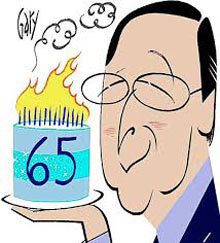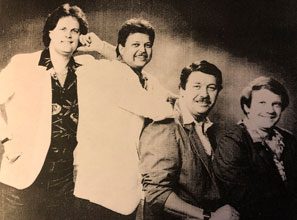 Midway through my molten walk with Dixie last week, we came upon an iridescent green lizard, perched alertly on a bush… all two inches of him. Who knew they could already crane their necks smartly at that size? I dubbed the little guy Freddie. Our encounter reminded me of William Falk’s recent editorial in The Week magazine:
Midway through my molten walk with Dixie last week, we came upon an iridescent green lizard, perched alertly on a bush… all two inches of him. Who knew they could already crane their necks smartly at that size? I dubbed the little guy Freddie. Our encounter reminded me of William Falk’s recent editorial in The Week magazine:
“In recent weeks, there’s been an avalanche of evidence of our species’ bottomless capacity for stupidity, savagery, and tribal hatred. An alarming number of our existing and would-be leaders have shown themselves to be clueless, corrupt, self-serving scoundrels and buffoons.”
Falk went on to laud mankind’s perennial capacity for towering acts of excellence wrapped in remarkable smarts, vision and teamwork. His examples included NASA’s Juno spacecraft beginning to orbit Jupiter after a 1.7 billion mile trek. He concluded optimistically with an unintended swipe at my little Freddie:
“Underneath their hyperdeveloped cerebral cortexes, even the most brilliant people have a lizard brain, pulsing with primitive impulses. But they provide proof that not all humans are imbeciles, and that’s consolation enough.”
Unlike dogs, who if provided with the basics of love, nutritious food, and reasonable care are dependably wonderful, humans are a grossly mixed bag. We range from unspeakably horrid to simply wondrous. Much of this startling variety (not what we usually mean by “diversity”) can be attributed to humans’ gaspingly complex brains and nervous systems. Combined with vastly different cultural and family environments in which we are raised—not to mention widely varying physical environments and climate– we have a coagulating jumble of forces that impinge on behavior.
As a student of WWII, I am drawn to this fascinating cocktail. How else to reckon the sweep of expression encompassed by the stunning brutality of Germany’s Nazi monsters and Japan’s fanatic killers, eventually overwhelmed by millions of glory bound Allied soldiers, sailors and airmen and legions of dutiful civilians who supported the war effort. For anyone who was underwhelmed by director George Clooney’s 2014 “Monuments Men,” Robert Edsel’s 2009 book by the same title provides welcome relief. Absent are the Hogan’s Heroes style goofy score and cartoonish plot. The real WWII story, detailed by Mr. Edsel, is far more detailed and complex. Yes, that’s an easy criticism to level at many movies in favor of related books, but in this case it’s particularly valid. “Rotten Tomatoes,” which summarized 228 reviews of this film, generated a lackluster 5.2/10 rating. The corresponding book reviews were excellent.
Why this disparity for “Monuments Men,” laying aside other book/movie comparisons? Historical books like Monuments which often run over 400 pages plus piles of references, frequently take the authors across continents and require years of research to piece together. Movies may also invoke complex issues, but frequently oversimplify plot lines and condense dialogue for mass audiences.
One is struck in Edsel’s book by the swirling cocktail of forces that came together—often violently—in battles over the preservation and custody of Europe’s greatest works of art and thousands of transcendent architectural gems. Hitler’s megalomaniacal quest to stock his Führermuseum, supported by his heinous regime, collided with the best instincts and better angels of the monuments men themselves, led by Clooney on-screen as Frank Stokes (the seemingly invincible George Stout led in real life). Lieutenant Stout’s valiant cultural warriors overcame nearly unimaginable obstacles on a shoestring budget and with virtually no conventional command and control authority lines (yes, they had FDR’s and Eisenhower’s blessing, plus the tacit support of General Patton’s Third Army). This story, which featured a bittersweet ending, traversed a bloody trail of detritus across France, Belgium, Holland, Germany, Austria and beyond. Reading “Monuments Men,” one grasps yet again the seeds of the historical forces which eventually resulted in the European Union. And fusses over the hot mess we call Brexit.
The often frustrating, bafflingly complex cocktail of human motives and goals has come into play once more in the roiling chaos we wake up to daily when we turn on the news. Punctuating terrible weather event stories is a nightmarish spin cycle of horror involving terrorist attacks interspersed with bloodshed involving often underappreciated American police officers.
We’ve traveled a meandering path since the fateful Boston police strike of 1919. As a college sophomore I was duly aghast in May, 1970 when four peers were gunned down senselessly by guardsmen at Kent State University. To me, then, “cops” were the bad guys. Just three years later, my tiny grad school office was right down the hall from our campus police headquarters. Given our location on Chicago’s south side and my pleasant daily interaction with them, I quickly migrated from being suspicious of “police” to a grateful supporter. They seemed all good guys, everywhere and always.
Both of these views, and so many of those bandied about today in endless media accounts, are often far too simplistic. The reality is that like any other population, police officers probably display normal statistical distributions (think bell curve) whenever we measure a relevant variable. Certainly any value, attitude, and yes, intelligence and competence. Police, like the rest of us, come in all shapes, sizes, and dispositions. Fitness for duty. Their training also varies widely. As do the communities they serve. There are also variations in local laws to factor in, such as those governing firearms.
In this case, as in others above, the cocktail is often lethal. Take apprehensive or depressed communities; mix in inadequate police training, suspect leadership, thousands of guns, and many individuals with mental health problems– often exacerbated by who knows what drugs they’re using—and what do you get? Exactly what you’d expect, chaos. Politicians, pundits and everyday opinionistas are too often guilty of retreating into their ideologically oversimplified corners and blasting away at the other side. Usually with words, bad enough, but all too often with weapons boasting extreme killing power.
This is no place for a list of simple solutions but it is worth harkening back to a simpler time in America and clear headed leadership. As future president Calvin Coolidge said, the year of the Boston strike,
“We must forever realize that material rewards are limited and in a sense they are only incidental, but the development of character is unlimited and is the only essential. The measure of success is not the quantity of merchandise, but the quality of manhood which is produced.”
Donning my own opinionista hat, I suggest that Congress commission a blue ribbon panel on violence. Their charter would be to quickly (within 30 days) draw upon all the best information available and their diverse experiences as ordinary citizens, activists, educators, data junkies and law enforcement professionals and issue broad yet detailed guidelines for state and local governments to consider. The goal is to drastically slow down the merry-go-round of mayhem.
Twelve people on this panel, like a jury. Men and women. Left, right, white, nonwhite, younger, older. Some with combat experience. And just maybe, one bartender. You know, someone accustomed to listening patiently to practically anyone.
Well, they’ll need someone to mix up a nice pitcher of something cool and refreshing for . . . a much needed cocktail when their daunting task is complete.
Cheers, everyone. Freddie, too. And God bless us all.
Â








